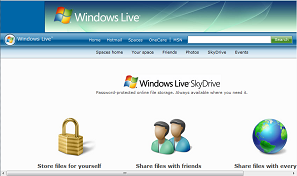Redux: New Synchronisation Idea Overlooked By Microsoft
I promised earlier I'd look deeper into microsoft's products around Synchronisation -- here's the first thing I want to make clear:
FolderShare and SkyDrive are completely different
or to put that another way:
But wait a second... are you retracting your earlier claims?
Yes and no. There is a massive fail here -- i'll get to that in a moment.
But first I want to clear up the differences between these two products.
SkyDrive is just online storage, and it has nothing to do with synchronizing those files to any location. There's no client side components (no shell extension, no explorer integration) no developer API -- nothing like that. But on the plus side it's 5 GIG, and it's deeply integrated with the spaces.live.com "on line presence" system.
FolderShare, on the other hand, is all about synchronizing files via the internet. There's no online storage at all. Instead you download and run a small client application (from here) on each of your machines, including Mac OSX. And thus, peer to peer connections can be established (i think they're encrypted and then proxied via microsoft servers) for synchronizing folders.
Each of these are very strong products, and very useful. You can find a lot of people who use and love these services.
Microsoft did a commendable thing when they bought foldershare, and made it free. Thank you!
But the massive fail belongs to...
The massive fail here belongs to the "cut and paste marketing" that's been used to push these two products.
It's a new term I'm coining for Marketing-Communication teams who plagiarise their own work.
Compare and contrast the difference in these two messages:
"Sharing with friends, co-workers, and family is easy..."
Folder Share marketing
"Sharing with friends, co-workers, or family is easy"
Sky Drive marketing...
And compare these two:
"access your personal files from anywhere online"
Sky Drive marketing...
"Access your files from any computer."
Folder Share marketing
The lesson for me is that while re-use is a Good Thing when writing code... it's not so good in the world of product positioning.
 DOES NOT EQUAL
DOES NOT EQUAL









